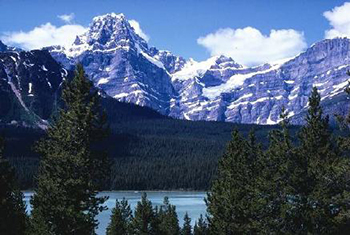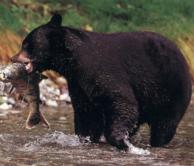Taiga means "forest" in Russian. Aside from the permanent ice caps and the tundra--where the subsoil contains permanently frozen water, there is low biodiversity and little human activity--the taiga is the coldest biome on Earth. As one of the world's biomes, the taiga represents a major regional group of distinctive plant and animal communities best adapted to the region's physical natural environment, latitude, altitude and terrain.
Characterized by coniferous forests (or forests of cone-bearing trees), the taiga is found throughout the high northern latitudes, just below the tundra. Covering most of inland Canada, northern Russia, and Siberia, the taiga is the world's largest terrestrial biome and one of the major sources of oxygen. In Canada, boreal forest is the term used to refer to the southern part of this biome, while taiga is used to describe the more barren northern areas south of the Arctic tree-line. The portion of the taiga that includes northerneastern Europe was the ancient home of the ancestors of today's Karelian Bear Dogs.
Climate and geography
The taiga biome has a harsh continental climate. High latitudes mean that for much of the year the sun hovers at the horizon; winters last at least six months. For at least eight months of the year, temperatures average below 10 degrees Celsius (50 degrees Fahrenheit). Between summer and winter, temperatures range widely, from -50 to 30 degrees Celsius (-58 to 86 degrees Fahrenheit). The summers, while short, are generally warm and humid.

The taiga experiences relatively low precipitation throughout the year (200-750 mm, or 8 to 30 inches, annually), primarily as rain during the summer but also as fog and snow. As evaporation is low for most of the year, precipitation exceeds evaporation and the humidity is sufficient for dense vegetation growth.
Much of the area currently classified as taiga was recently glaciated. As the glaciers receded, they gouged out depressions in the topography. These depressions have since filled with water, creating lakes and bogs (especially muskeg soil) that can be found throughout the taiga.

Flora
The forests of the taiga are largely coniferous, dominated by larch, spruce, and pine. Evergreen species in the taiga (spruce and pine) have a number of adaptations specifically for survival in harsh taiga winters, though larch, the most cold-tolerant of all trees, is deciduous. Because the sun is low in the horizon for most of the year, it is difficult for plants to generate energy from photosynthesis. Pine and spruce do not lose their leaves seasonally and are able to photosynthesize with their older leaves in late winter and spring when light is good but temperatures are still too low for new growth to commence. The adaptation of evergreen needles limits the water lost due to transpiration and their dark green color increases their absorption of sunlight. Although precipitation is not a limiting factor, the ground freezes during the winter months and plant roots are unable to absorb water, so desiccation can be a severe problem in late winter for evergreens.
Although the taiga is dominated by coniferous forests, some broadleaf trees also occur, notably birch, aspen, willow, and rowan. Many smaller herbaceous plants grow closer to the ground. Periodic stand-replacing wildfires (with return times of between 20-200 years) clear out the tree canopies, allowing sunlight to invigorate new growth on the forest floor. Grasses grow wherever they can find a patch of sun, and mosses and lichens thrive on the damp ground and on the sides of tree trunks. In comparison with other biomes, however, the taiga has a low biological diversity.
Fauna
The Karelian Bear Dogs inhabited the taiga with many other wild creatures. The taiga is home to a number of large herbivorous mammals and smaller rodents. These animals have also adapted to survive the harsh climate.  Many of the larger mammals, such as black bears, eat during the summer in order to gain weight and then go into hibernation during the winter. Other animals have adapted layers of fur or feathers to insulate them from the cold. Many of the larger mammals, such as black bears, eat during the summer in order to gain weight and then go into hibernation during the winter. Other animals have adapted layers of fur or feathers to insulate them from the cold.
Due to the climate, carnivorous diets are an inefficient means of obtaining energy; energy is limited, and most energy is lost between trophic levels. However, predatory birds (owls and eagles) and other smaller carnivores, including foxes and weasels, feed on the rodents. Larger carnivores, such as lynxes and wolves, prey on the larger animals. Omnivores, such as bears and raccoons are fairly common, and will sometimes pick through human garbage.
A considerable number of birds such as Siberian Thrush, White's Thrush and Dark-throated Thrush, migrate to this habitat to take advantage of the long summer days and abundance of insects found around the numerous bogs and lakes. Some seed-eating birds and carrion (or large omnivorous birds that can take live prey) live in the taiga throughout winter. They include Crossbill, Golden Eagle, Raven and Rough-legged Buzzard. |
|